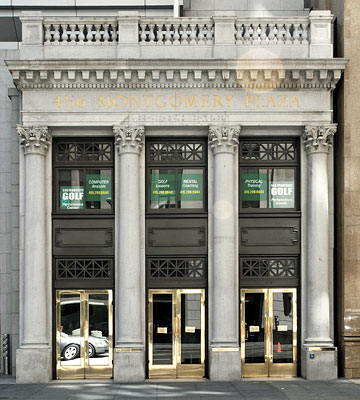San Francisco Landmarks
Borel and Company
440 Montgomery Street Between California and Sacramento
Built 1908
The Borel and Company building is a small two story granite-faced steel frame building designed by Albert Pissis. It exemplifies the Beaux Arts commercial classicism strongly evident in the reconstruction of downtown San Francisco following the 1906 Earthquake and Fire.
The fine Corinthian façade begins the colonnaded parade of temple banks that runs northward along Montgomery Street almost without interruption to Columbus Avenue.
In this small commercial building - its facade only 27.5 feet wide - the genius of Albert Pissis shines forth no less brilliantly than in his major works. While the design of a facade for a building of this size would, in a sense, offer less opportunity for innovation than would a larger street frontage, paradoxically, it also demands even greater innovation to achieve architectural excellence, and in this Pissis was eminently successful.
Adapted from San Francisco Planning Commission Resolution 8418 dated 15 November 1979


The A. Borel Company Building was commissioned by Antoine Borel, banker and diplomat, who had been born in Switzerland in 1840. Although generally thought of as a commercial bank, the type of service offered was more closely related to investment services.
Borel he held directorates in the California-Oregon Power Company, the Los Angeles Railroad, The Spring Valley Water Company, and the Bank of California.
In 1884, Borel organized a syndicate to purchase the California Street Cable Car line which had been in operation since 1878. It was largely through Borel's efforts that the company expanded its operations by construction of the Hyde Street Line.

Façadism
Wikipedia defines Façadism (or Façadomy) as the practice of demolishing a building but leaving its façade intact for the purposes of building new structures in it or around it.
The International Charter for the Conservation and Restoration of Monuments and Sites (The Venice Charter of 1964) provided the doctrinal foundation for the modern preservation movement.
Although the United States did not participate in the preparation of the charter, the charter provided the basis for the Secretary of Interior's Standards for Historic Preservation. US/ICOMOS was founded in the 1960s to foster heritage conservation and historic preservation.
Article 1 of the Venice Charter
The concept of a historic monument embraces not only the single architectural work but also the urban or rural setting in which is found the evidence of a particular civilization, a significant development or a historic event. This applies not only to great works of art but also to more modest works of the past which have acquired cultural significance with the passing of time.
Article 7 of the Venice Charter
A monument is inseparable from the history to which it bears witness and from the setting in which it occurs. The moving of all or part of a monument cannot be allowed except where the safeguarding of that monument demands it or where it is justified by national or international interest of paramount importance.
Article 13 of the Venice Charter
Additions cannot be allowed except in so far as they do not detract from the interesting parts of the building, its traditional setting, the balance of its composition and its relation with its surroundings.
Paul Golderberger, writing in the New York Times on 15 July 1985 (Façadism on the Rise: Preservation or Illusion?), gives an argument against urban façadism.
For façadism holds out a great temptation. It seems, on the surface, to give both sides what they want. The small, older buildings valued by preservationists appear to be saved, while the large new ones developers seek can still be built.Façadism in San Francisco:But while façadism pretends to a certain earnestness, it is at bottom rather pernicious. For the compromise it represents is not really preservation at all. To save only the facade of a building is not to save its essence; it is to turn the building into a stage set, into a cute toy intended to make a skyscraper more palatable. And the street becomes a kind of Disneyland of false fronts.
- Belli Building, 722 Montgomery Street
- Borel and Company, 440 Montgomery Street
- Engine Company No. 14 , 1047 McAllister Street
- Genella Building, 726-728 Montgomery Street
- Hoffmann Grill Building, 619 Market Street
- Italian American Bank, 460 Montgomery Street
- South End District
- United States Mint & Subtreasury, 608 Commercial Street
- Minden Butter Manufacturing Company, Minden, NV
